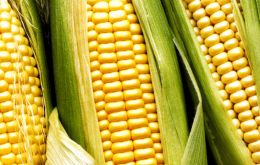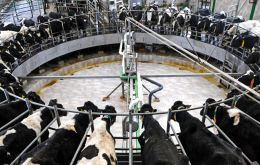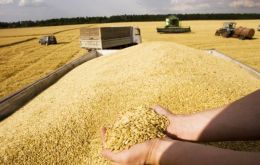MercoPress. South Atlantic News Agency
Tag: FAO Food Price Index (FPI)
-
Wednesday, April 9th 2025 - 07:48 UTC
FAO March Food Prices, cereals and sugar down, sharp increase in vegetable oils

The FAO Food Price Index, a benchmark indicator of global food price developments, remained virtually unchanged in March from its revised February reading, as lower global cereal and sugar quotations offset sharp increases in vegetable oil prices.
-
Friday, February 7th 2020 - 19:06 UTC
World food prices rose for the fourth consecutive month in January

The FAO Food Price Index averaged 182.5 points during the month, up 0.7 percent from December and 11.3 percent higher than the same month a year earlier. Vegetable oils, sugar, and wheat were the chief drivers of the index, which tracks monthly changes in the international prices of commonly-traded food commodities.
-
Thursday, August 4th 2016 - 22:59 UTC
FAO Price Index reports modest decline in July as grains and vegetable oils drop

The international prices for major food commodities saw a modest decline in July, following five consecutive months of increases. The FAO Food Pice Index (FPI) averaged 161.9 points in July 2016, slipping 0.8 percent (1.3 points) below its level in June and 1.4 percent below its level of July 2015.
-
Friday, April 8th 2016 - 07:04 UTC
FAO Food Price Index in March: sugar up, dairy products down and meats stable

The FAO Food Price Index for March rose by 1.0% compared to February, as soaring sugar prices and continued increase in palm oil quotations more than offset plunging dairy product prices. The Index averaged 151.0 points in March, its highest level in 2016, but still some 12.0% below its level of a year earlier.
-
Tuesday, November 10th 2015 - 06:33 UTC
FAO food commodity prices rose in October 3.9%, but 16% down from a year earlier

The FAO Food Price Index averaged nearly 162 points in October, up 3.9% from September, while still down 16% from a year earlier. FAO's latest Cereal supply and Demand Brief slightly trimmed its October 2015 forecast for global cereal production and now projects production at 2.53 billion tons, 1.1% below last year's record output
-
Friday, September 11th 2015 - 09:58 UTC
FAO's August Food Price Index at its lowest in almost seven years

International food commodity prices continued to decline in August as ample supplies, a slump in energy prices and concerns over China's economic slowdown all contributed to the sharpest fall of the FAO Food Price Index in almost seven years.
-
Monday, March 9th 2015 - 11:45 UTC
February's FAO Food Price Index at is lowest value since early 2010

The FAO Food Price Index averaged 179. 4 points in February 2015, down 1.8 points (1.0 percent) from its January value and 29 points (14.0 percent) below its level in February 2014. Prices of cereals, meat and, especially, sugar, dipped last month, while they remained steady in the case of oils and rebounded sharply in the case of dairy products. The index has been on a declining path since April 2014 and has now reached its lowest value since July 2010.
-
Saturday, January 10th 2015 - 06:28 UTC
FAO Food Price index falls in 20014 on large cereals' supplies and record stocks

FAO's monthly Food Price Index declined in December after three months of stability. Continued large supplies and record stocks combined with a stronger U.S. dollar and falling oil prices contributed to the decline, which helped bring the 2014 overall Food Price Index down 3.7%.
-
Thursday, December 11th 2014 - 12:40 UTC
FAO food price index in November remained stable for third month running

FAO's monthly food price index was stable in November, as vegetable oil and grain prices inched up and offset ongoing declines in dairy prices. The Food Price Index averaged 192.6 points, marking the third consecutive month of stability. The Index now stands 13 points, 6.4 percent below its level in November 2013.
-
Saturday, March 8th 2014 - 06:02 UTC
February experienced a sharp increase in FAO Food Prices Index

Weather-related events and increased demand came into play as the FAO Food Price Index registered its sharpest increase since mid-2012, averaging 208.1 points in February 2014. The new level is 5.2 points, or 2.6%, above a slightly revised index for January, but is still 2.1% lower than last year at the same time.
